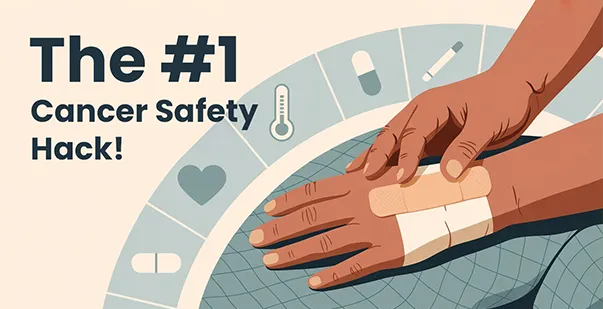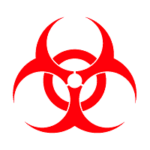It’s 2:17 a.m, a caregiver wakes up suddenly j to the sound of coughing, sharp, relentless. In the dim light, she sees her father, pale and shaking, struggling to breathe. He’s halfway through a chemotherapy cycle, and his immune system is fragile. Panic swells, but she remembers what to do, checks his temperature, positions him upright, calls for help, and begins basic care. Those first five minutes matter more than anything else.
As more cancer patients receive treatment at home, families are stepping into key roles, often without any clinical training. As per the National Library of Medicine (2018), nearly 60% of caregivers say they’ve never received instruction on handling medical tasks, leaving them unsure during emergencies.
This guide breaks down how basic first aid training for caregivers can make all the difference, so that in those 2:17 a.m. moments, action replaces panic.
How to Care for Cancer Patients at Home
Bringing home care for cancer patients comes with specific safety concerns. Treatments like chemotherapy, radiation, and surgery can weaken the immune system and cause extreme tiredness. They also often involve complicated medication routines. If you’re a caregiver, especially without medical training, you’ll need to manage these issues carefully. Your role is to help keep the environment safe and support the patient through their recovery at home.
1. Infection Control for Immunocompromised Patients
Cancer treatments can lead to neutropenia, significantly increasing infection risk. To mitigate this:
- Hand Hygiene: All household members should practice regular handwashing with soap and water, and you’re relying on hand sanitizer, ensure that it is 60% strength or greater if soap and water isn’t available.
- Vaccinations: Patients and caregivers should stay up-to-date with vaccinations, including the annual influenza shot, after consulting with healthcare providers.
- Avoiding Exposure: Limit contact with individuals exhibiting signs of illness, according to the American Cancer Society. For example, if a friend has a cold, it’s best to postpone in-person visits or switch to a video call instead.
- Food Safety: Ensure proper food handling and avoid raw or undercooked foods, such as sushi, rare meats, runny eggs, unpasteurized milk, and soft cheeses like brie or feta, which can carry harmful bacteria.
- Environmental Cleanliness: Regularly disinfect frequently touched surfaces.
- Ventilation: Improve indoor air quality by opening windows when possible and using air purifiers to reduce airborne pathogens.
- Neutropenic Precautions: In some cases, doctors may recommend specific infection control measures known as neutropenic precautions. These are protocols designed to protect individuals with very low white blood cell counts and may include stricter hygiene and visitor guidelines.
2. Safe Handling and Disposal of Medications
Certain cancer medications, including oral chemotherapies, are hazardous and require careful handling:
- Personal Protective Equipment: Caregivers should wear gloves when handling medications or contaminated materials.
- Medication Storage: Store medications in original containers, out of reach of children and pets. Wash hands before and after giving meds, check expiry dates regularly, and ask your pharmacy about disposal bags or bins.
- Disposal: Follow guidelines for disposing of unused medications and contaminated waste.
- Avoid Altering Medications: Do not crush or split pills unless directed by a healthcare provider.
For more information on safe disposal methods and to find a take-back program near you, visit the FDA’s Safe Disposal of Medicines page.
3. Fall Prevention Strategies
Cancer patients may experience balance issues due to treatment side effects:
- Home Modifications: Install grab bars in bathrooms, use non-slip mats, and ensure adequate lighting.
- Clear Pathways: Remove tripping hazards like loose rugs and clutter.
- Assistive Devices: Use canes or walkers as recommended.
- Regular Exercise: Engage in activities to maintain strength and balance, as advised by healthcare providers. Simple exercises like gentle yoga or seated leg lifts can be effective and safe options.
- Professional Assessment: Consider a fall risk assessment by an occupational therapist or visiting nurse to identify personalized safety recommendations.
4. Emergency Preparedness
Being prepared for emergencies is of the essence, as per the CDC:
- Emergency Kit: Maintain a kit with essential items, including a list of medications, lashlight, extra batteries, backup phone charger, sugar tablets if diabetic, medical records, and contact information, and hard copies of the patient’s insurance and ID.
- Backup Contacts: Designate an emergency contact who can assist if needed.
- Communication Plan: Ensure all caregivers are informed about emergency procedures and to use shared calendars or group messaging apps for coordination.
5. Management of Medical Equipment
Proper use and maintenance of medical equipment are essential:
- Training: Caregivers should receive proper instruction on using equipment like infusion pumps, feeding tubes, or oxygen tanks.
- Maintenance: Check devices regularly for functionality and cleanliness. Follow cleaning protocols for reusable items, use disinfectants approved for medical equipment (e.g., alcohol-based wipes or diluted bleach solutions, as recommended by the manufacturer).
- Power Backup: For powered medical devices such as oxygen concentrators, have a battery backup or power outage plan in place.
- Emergency Protocols: Be prepared to respond to equipment malfunctions. Keep emergency contact information with the equipment so visiting nurses or first responders can access it quickly if needed.
6. Emotional and Mental Health Support
Addressing the psychological well-being of cancer patients is important:
- Open Communication: Encourage discussions about feelings and concerns.
- Professional Support: Seek counseling or support groups as needed.
- Routine: Maintain a structured daily schedule to provide a sense of normalcy.
- Caregiver Well-being: Caregivers are at high risk for burnout. Prioritize your own mental health with tools like Calm, Headspace, or journaling apps that support stress relief and mindfulness.
- Digital Resources: Online communities such as CancerCare, CaringBridge, or Smart Patients offer connection and shared experiences for both patients and caregivers.
The Role of First Aid Training in Managing Medical Emergencies
First aid training for caregivers teaches how to handle medical emergencies with calm and skill. Whether it’s a fall, bleeding, fainting, or an allergic reaction, knowing what to do right away can make a big difference. It can help prevent serious problems and support recovery:
Falls and Fractures
Take a fall, for example. If you’re trained, you’ll know how to check for a possible fracture. You’ll also know how to keep the head or spine still if needed, and how to keep the person calm until help arrives.
Bleeding
In a bleeding emergency, you’ll know how to press down on the wound, raise the injured area, and use clean bandages to lower the risk of infection.
Chest Pain or Trouble Breathing
If someone suddenly has chest pain or difficulty breathing, your training helps you recognize these as possible signs of a heart attack or respiratory distress—and respond immediately.
Diabetic Episodes
First aid training also prepares you to act fast in cases of low or high blood sugar, helping you spot symptoms like confusion, sweating, or fainting before they escalate.
Creating a Safe Home Environment: Practical Tips
Cancer treatments can cause fatigue, nerve damage, and balance issues, making everyday activities riskier. Small, targeted home modifications can help prevent falls, reduce infection risk, and support recovery.
1. Install Grab Bars and Support Rails
Place grab bars beside the toilet and inside the shower or tub areas where falls are most common. Use horizontal, wall-anchored bars that can support at least 250 pounds. Avoid suction bars; they’re unreliable. For staircases and long hallways, add handrails on both sides. Stainless steel bars are ideal for wet areas because they resist rust and offer a strong grip.
If you’re renting, check with your landlord before installing permanent fixtures. Temporary rail options—like tension-mounted or clamp-on bars—are available and can be a safer alternative without requiring drilling.
2. Eliminate Tripping Hazards
Remove loose rugs or secure them with non-slip backing. Tape down cords and keep walkways completely clear, especially the path from bed to bathroom. Replace slippery floors with non-slip options like rubber or textured vinyl. Avoid clutter. Even a small misplaced item can cause a serious fall. Avoid clutter—even a small misplaced item, like a pet toy or food bowl, can cause a serious fall. Keep these out of common walking areas whenever possible.
To minimize overreaching or bending, use grab tools or reachers to safely pick up items from the floor or high shelves. This simple tool can prevent unnecessary strain and potential falls.
3. Improve Lighting Throughout the House
Use LED bulbs rated 4000K–5000K for bright, clear visibility. Install nightlights in bedrooms, hallways, and bathrooms to reduce fall risk at night and backup lighting during power outages. Add motion-sensor lights in high-traffic areas. Ensure light switches are easy to find and reachable, consider backlit or glow-in-the-dark models.
4. Organize and Secure Medications
Store medications in a dry, cool place, never the bathroom. If refrigeration is required, keep them in a separate container away from food. Use weekly pill organizers to avoid missed doses. Label everything clearly and maintain a current list of medications. Lock away anything hazardous or unnecessary. Properly dispose of expired drugs to avoid accidental use.
5. Address Bathroom Safety
Install a raised toilet seat to make sitting and standing easier. Use a shower chair and a handheld showerhead to reduce movement while bathing. Set water heaters to 120°F (49°C) to avoid burns, especially if the patient has numbness or sensitivity issues. Place non-slip mats both inside and outside the shower. Keep the floor dry and clean.
Consider a non-slip bench just outside the shower to make drying off and dressing safer and more stable. If the patient has nerve damage or hand tremors, store razors and other sharp items out of reach to prevent accidental injury.
6. Prepare for Emergency Situations
Use wearable medical alert systems that allow immediate help if the patient falls. Place phones or intercoms in every major room. Make sure smoke and carbon monoxide detectors are installed and working. Post emergency numbers in plain sight, on the fridge, next to the bed, or near the phone.
Commonly Asked Questions on Cancer Patient Safety at Home
Understanding how first aid training for caregivers fits into at-home cancer care can clear up many practical concerns caregivers and family members have. Below are some of the most frequent questions people ask, with direct and helpful answers to guide safe decision-making.
1. What specific emergencies should I be prepared for when caring for a cancer patient at home?
Cancer patients may experience various emergencies, including falls, bleeding (especially if they have low platelet counts), infections due to weakened immunity, and adverse reactions to medications. First aid training equips caregivers to handle such situations effectively, ensuring timely and appropriate responses until professional medical help is available.
Talk to your doctor about tailoring emergency plans to your loved one’s condition.
2. How can first aid training help in managing the side effects of chemotherapy or radiation therapy?
While first aid training for caregivers doesn’t replace medical treatment, it provides caregivers with the skills to manage side effects like nausea, vomiting, and skin irritations. For instance, understanding how to care for skin affected by radiation or how to address mouth sores can significantly improve a patient’s comfort and prevent complications.
Talk to your doctor about how to manage side effects specific to the treatment plan.
3. What should be included in a first aid kit for a cancer patient?
A comprehensive first aid kit for a cancer patient should contain:
- Sterile dressings and bandages
- Antiseptic wipes and solutions
- Thermometer and gloves
- Medications for managing side effects (as prescribed)
- Emergency contact numbers
Talk to your doctor or nurse about what else to include based on your situation.
4. Can first aid training help in reducing hospital visits for cancer patients?
Yes, by effectively managing minor injuries or side effects at home, caregivers can prevent situations from escalating, thereby reducing unnecessary hospital visits. Proper wound care, infection control, and timely intervention in emergencies can make a significant difference.
Talk to your doctor about which situations can be safely managed at home.
5. Where can caregivers receive first aid training tailored for cancer patient care?
Organizations like the American Red Cross and local healthcare institutions often offer first aid courses. Some programs are specifically designed for caregivers, focusing on the unique needs of cancer patients. It’s advisable to consult with local hospitals or cancer support centres for recommendations on suitable training programs.
Talk to your care team about training options available near you.
The Lifesaving Impact of First Aid Training
Taking cancer patient care at home means focusing on their safety, comfort, and emotional needs. You need to manage several things at once, keeping infections under control, handling medications properly, preventing falls, and staying ready for emergencies. These steps help create a safe and steady environment.
But safety isn’t just physical. Supporting the patient’s emotional and mental well-being matters just as much. Keep communication open, and don’t hesitate to reach out to professionals if you need extra help. Learning basic first aid also makes a big difference. It prepares you to handle emergencies and might even reduce the need for hospital visits.
When you follow these simple but important practices, you make a real difference. You help your loved one heal and feel cared for, right at home.






